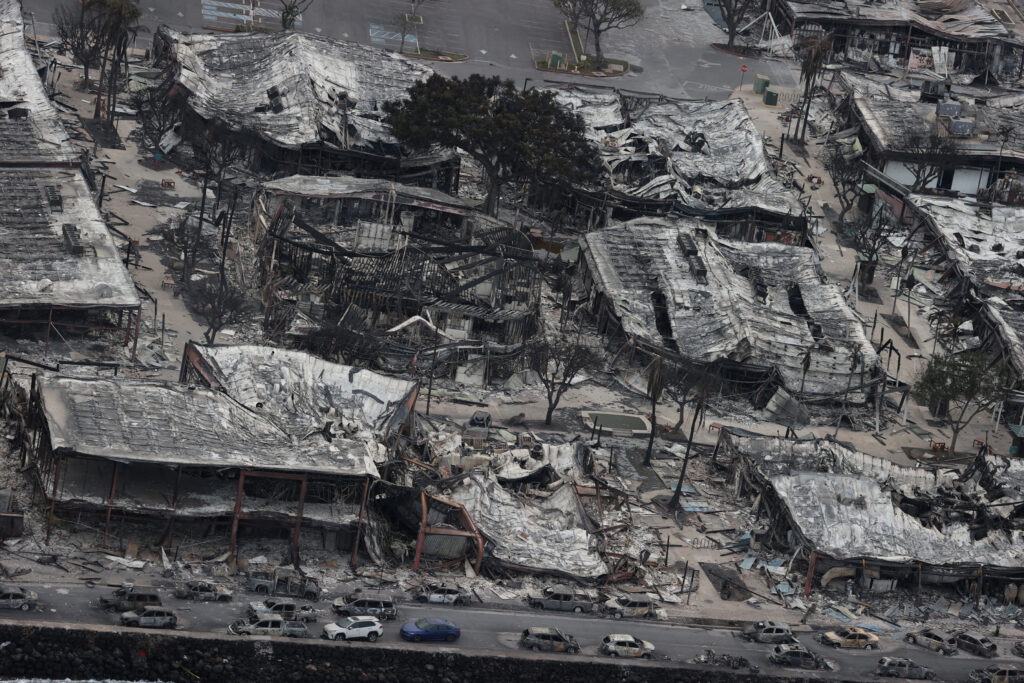
Views from the air of the community of Lahaina after wildfires driven by high winds burned across most of the town several days ago, in Lahaina, Hawaii, U.S. August 10, 2023. REUTERS/Marco Garcia
KAHULUI, Hawaii—The death toll from Maui’s wildfires rose to 53 on Thursday as the fast-moving conflagration that turned the resort town of Lahaina into smoldering ruins was 80-percent contained, officials said.
The island that forms part of the U.S. state of Hawaii was caught off guard by at least three major fires that broke out Tuesday night, cutting off the western side of the island and the historic city of Lahaina, where more than 270 structures were destroyed or damaged.
Many more people suffered burns, smoke inhalation and other injuries. Search and rescue efforts continue, and thousands of people have fled into emergency shelters or left the island.
READ MORE: Maui wildfires kill six as ‘apocalypse’ strikes Hawaiian paradise
The wildfires took most of Lahaina’s residents and visitors by surprise, forcing some to jump into the ocean to escape the fast-moving inferno. Thousands of tourists were trying to leave Maui, many of them camped in the airport waiting for flights.
Vixay Phonxaylinkham, a tourist from Fresno, California, said he was trapped on Lahaina’s Front Street in a rental car with his wife and children as the fires approached, forcing the family to abandon the car and jump into the Pacific Ocean.
“We floated around four hours,” Phonxaylinkham said from the airport while awaiting a flight off the island, describing how they held onto pieces of wood for floatation.
“It was a vacation that turned into a nightmare. I heard explosions everywhere, I heard screaming, and some people didn’t make it. I feel so sad,” he said.
The death toll rose by 17 on Thursday to reach 53, Maui County said in a statement that also reported the Lahaina fire was 80% contained, as firefighters secured the perimeter of the wildland areas that burned.
The Pulehu fire, about 20 miles (30 km) east of Lahaina, was 70% contained. There was no estimate for the Upcountry fire in the center of the eastern mass of the island, Maui County said.
The Lahaina fire reduced entire neighborhoods to ashes on the western side of the island. Lahaina is one of Maui’s prime attractions, drawing 2 million tourists each year, or about 80% of the island’s visitors.
Tourists and locals alike fled with few or none of their belongings as the fire spread rapidly due to dry conditions, a buildup of fuels and strong winds.
“It was so hot all around me, I felt like my shirt was about to catch on fire,” said Nicoangelo Knickerbocker, a 21-year-old resident of Lahaina, said from one of the four emergency shelters opened on the island.
Knickerbocker heard cars and a gas station explode, and soon after fled the town with his father, bringing with them only the clothes they were wearing and the family dog.
“It sounded like a war was going on,” he said.
Most of the roughly 400 evacuees at the War Memorial shelter on Thursday morning had arrived in shock, with an “empty look,” said Dr. Gerald Tariao Montano, a pediatrician who volunteered to work a six-hour shift on Wednesday night.
“Some haven’t fully grasped that they lost everything,” he said, pleading for donations of clothes, supplies, food, baby formula and diapers.
The fires were the worst disaster to befall Hawaii since 1960, one year after it became a U.S. state, when a tsunami killed 61 people.
The fate of some of Lahaina’s cultural treasures remains unclear. The historic 60-foot(18-meter)-tall banyan tree marking the spot where Hawaiian King Kamehameha III’s 19th-century palace stood was still standing, though some of its boughs appeared charred, according to a Reuters witness.
“We will need to rebuild the entirety of Lahaina, I believe,” Governor Green told KHON 2 television.
U.S. President Joe Biden approved a disaster declaration for Hawaii, allowing affected individuals and business owners to apply for federal housing and economic recovery grants.
The cause of the Maui wildfires has yet to be determined, officials said, but the National Weather Service said dry vegetation, strong winds, and low humidity fueled them.
Wildfires occur every year in Hawaii, according to Thomas Smith, an environmental geography professor at the London School of Economics and Political Science, but this year’s fires are burning faster and bigger than usual.
The Big Island of Hawaii also experienced at least two major brush fires.
Scenes of fiery devastation have become all too familiar elsewhere in the world this summer. Wildfires, often caused by record-setting heat, forced the evacuation of tens of thousands of people in Greece, Spain, Portugal and other parts of Europe. In western Canada, a series of unusually severe fires sent clouds of smoke over vast swaths of the U.S., polluting the air.
Human-caused climate change, driven by fossil fuel use, is increasing the frequency and intensity of such extreme weather events, scientists say, having long warned that countries must slash emissions to prevent climate catastrophe.